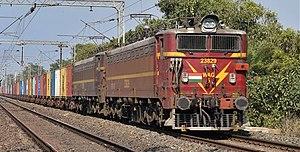| WAG-5 |
|---|
 Jhansi ELS based WAG-5 twins with CONCOR rakes |
|
| Specifications |
|---|
Configuration:
| |
|---|
| • UIC | Co′Co′ |
|---|
| Gauge | 5 ft 6 in (1,676 mm) |
|---|
| Bogies | ALCO Asymmetric cast frame trimount |
|---|
| Wheel diameter | - New: 1,092 mm (3 ft 7 in)
- Half worn: 1,055 mm (3 ft 5 1&fras1;2 in)
- Full worn: 1,016 mm (3 ft 4 in)
|
|---|
| Length | 17.162 m (56 ft 3 11&fras1;16 in) |
|---|
| Width | 3.055 m (10 ft 1&fras1;4 in) |
|---|
| Height | 1.997 m (6 ft 6 5&fras1;8 in) |
|---|
| Axle load | 20 tonnes (20 long tons; 22 short tons) |
|---|
| Loco weight | 119 tonnes (117 long tons; 131 short tons) |
|---|
| Electric system/s | 25 kV 50 Hz AC Overhead |
|---|
| Current pickup(s) | pantograph |
|---|
| Traction motors | Alstom TAO 659/Hitachi HS15250A |
|---|
| MU working | 4 |
|---|
| Loco brake | Air/Hand |
|---|
| Train brakes | Air, Dual and Vacuum |
|---|
| Safety systems | Slip control, Main overload relay, Over voltage relay, No volt relay, Earth fault relay, Low pressure governor, Train parting alarms, Vigilance Control Device(VCD) and Brake cylinder cutoff valve |
|---|
|
| Performance figures |
|---|
| Maximum speed | 105 km/h (65 mph)/ 100 km/h (62 mph)
or80 km/h (50 mph) |
|---|
| Power output | Max:4,300 hp (3,210 kW) |
|---|
Tractive effort:
| |
|---|
| • Starting | 37,500 kgf (370 kN) |
|---|
| • Continuous | 33,600 kgf (330 kN) |
|---|
| Factor of adh. | 0.29 |
|---|
|
| Career |
|---|
| Operators | Indian Railways |
|---|
| Numbers | 21100–21153, 23000–23800 & 24001–24075 |
|---|
| Nicknames | Krishnaveni |
|---|
| Locale | All over India |
|---|
| Disposition | active |
|---|
|
The Indian locomotive class WAG-5 is a class of 25 kV AC electric locomotives that was developed in 1968 by Chittaranjan Locomotive Works for Indian Railways. The model name stands for broad gauge (W), alternating current (A), goods traffic (G) engine, 5th generation (5). They entered service in 1980. A total of 1196 WAG-5 were built at CLW and BHEL between 1970 and 1998, which made them the most numerous class of mainline electric locomotive till its successor the WAG-7.
See also
References
External links
This article is copied from an
article on Wikipedia® - the free encyclopedia created and edited by its online user community. The text was not checked or edited by anyone on our staff. Although the vast majority of Wikipedia® encyclopedia articles provide accurate and timely information, please do not assume the accuracy of any particular article. This article is distributed under the terms of
GNU Free Documentation License.
All content on this website, including dictionary, thesaurus, literature, geography, and other reference data is for informational purposes only. This information should not be considered complete, up to date, and is not intended to be used in place of a visit, consultation, or advice of a legal, medical, or any other professional.
